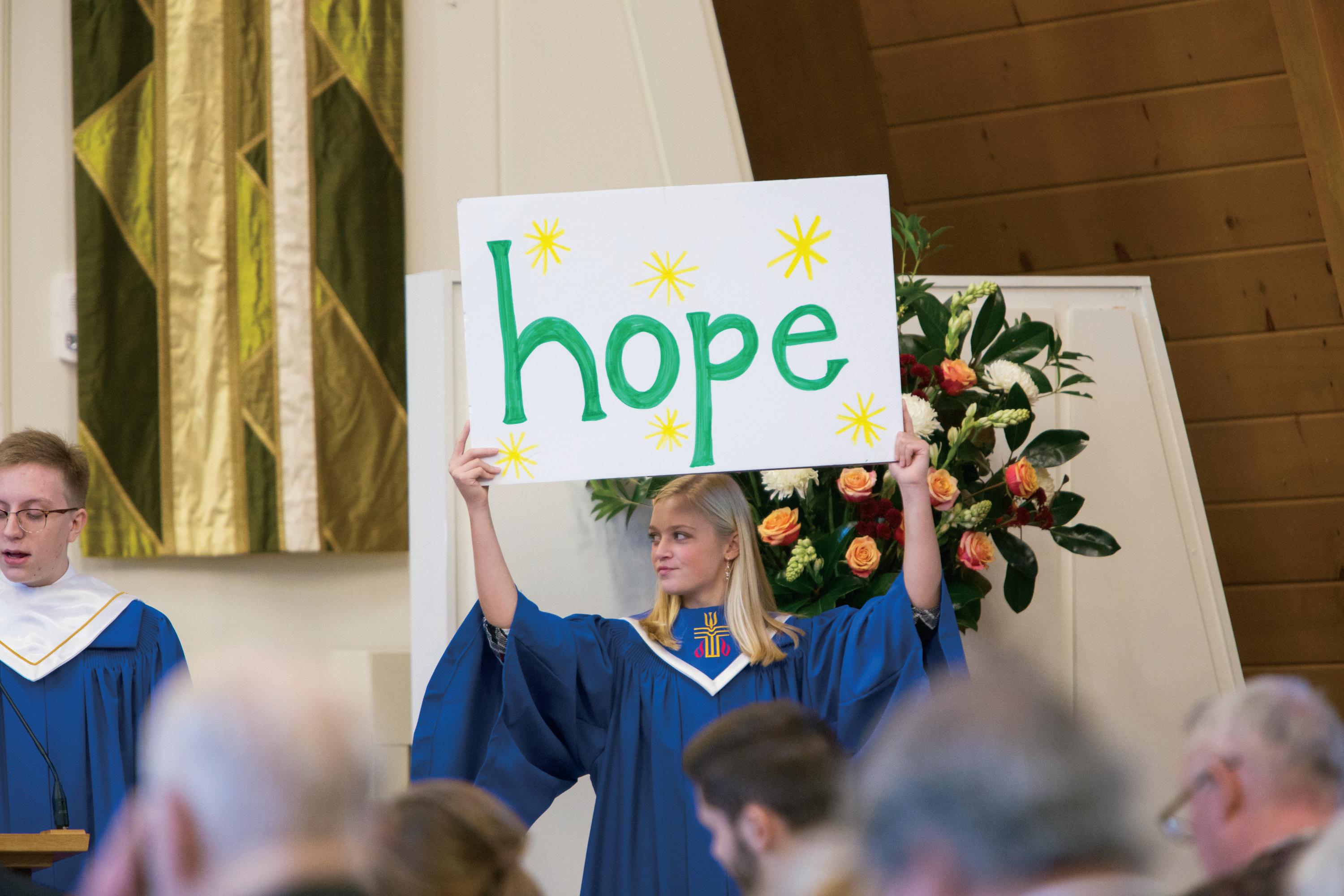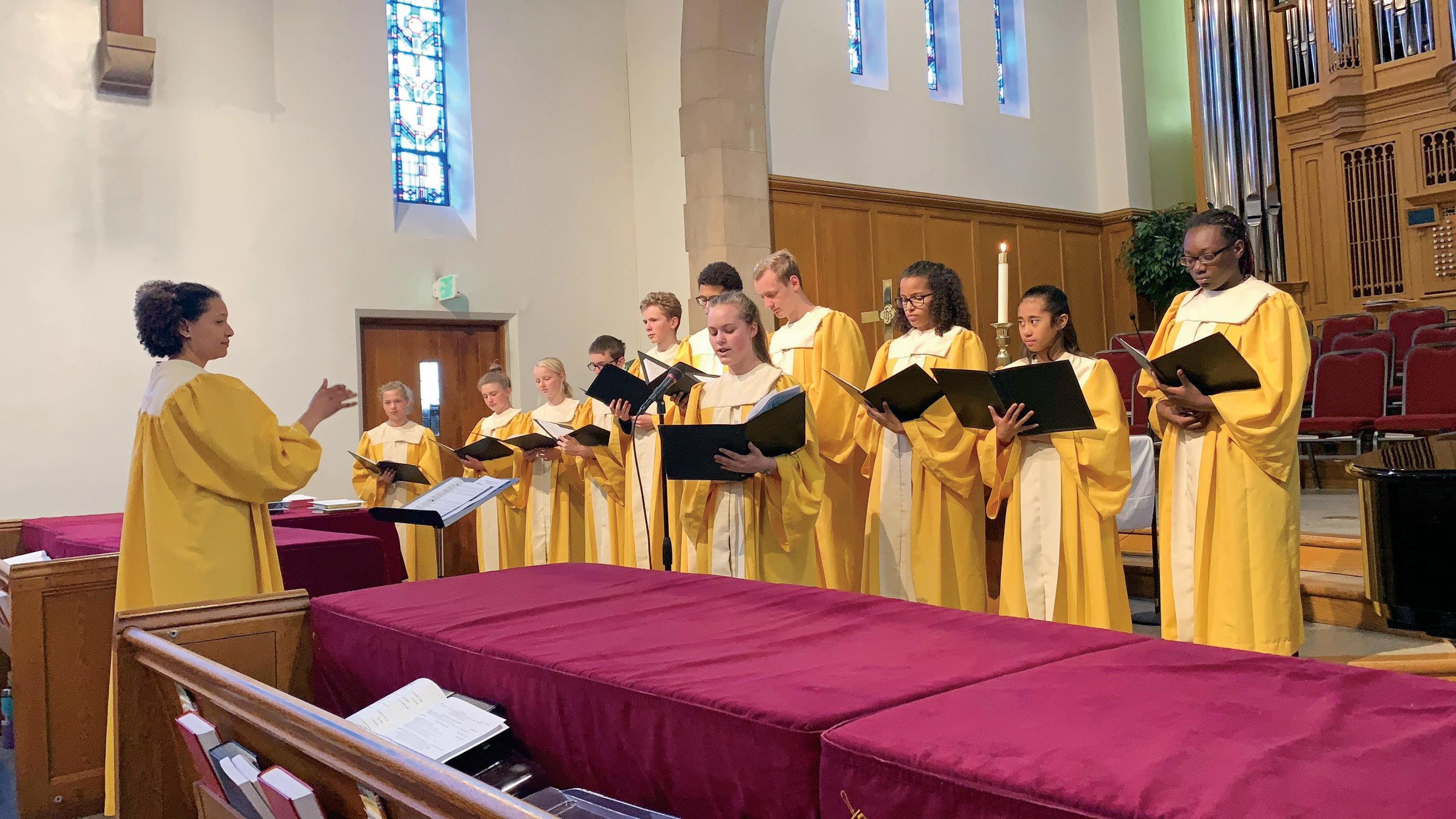
10 minute read
You Are Welcome Here! Equity, Inclusion and Social Justice in the Choir Room
Genesis Choir (6-12 graders) during our visit to Colorado Springs
BY WANDA VÁSQUEZ DE GARCIA
My first experience at a religious service in the United States was at age 25 at the First Lutheran Church in Decorah, Iowa. I was pregnant with my second child, and my then two and a half year-old son and I had just been reunited with my husband who had come a year earlier to Luther College to finish his bachelor's degree in music. He was a non-traditional student with a family in tow. I remember going into the church building really not knowing what to expect. We were invited by one of their pastors who also worked for Luther and happened to be Latinx — we find each other everywhere! As we entered the building, we were immediately welcomed by the congregation. We followed a member to the basement for coffee before the service. I stayed very close to my husband as he was fluent in English and back then, I could barely say the proper greetings taught in English 101.
When the service began, the sound of the opening hymn in four-part singing by the congregation was a very welcomed sound. You see, I had been singing in choirs for my entire life, back in the Dominican Republic. Soon, a hymnal and bulletin were handed to us. The sight of printed music was a relief. But when I thought I knew what I was going to do, I noticed the language and shied away. I resorted to my training and sang the alto part using neutral syllables. At the end of the service, I didn’t feel like I was fully a participant or that I contributed to the worship. Did God appreciate my offering?
I didn’t feel that I belonged there, even though we loved and worshiped the same God.
My experiences at Luther College are some of my best memories. I give thanks to God for leading me there.
I tell you this story because stories are important. The foundation of our faith is based on the stories found in the Holy Book.
As I interact with my singers, one of my most important goals is to build trust and create a space where they can tell their stories. When that level of trust is built there is nothing that you cannot achieve. I trust my singers and they trust me.
The congregation to which I belong, and where I lead one of the children choirs (second through fifth graders) and the youth choir (sixth through twelfth graders), is a very special one. We are all about our immediate community and loving our neighbor like we want to be loved. I feel that love. We begin every service like this “Seekers and believers, people of faith, people of no faith at all, no matter who you are, no matter where you are on life's journey — You Are Welcome Here!”
Whenever I program something out of the comfort zone of our congregation, it is always received with open arms. We are constantly trying to reach out to the community around us. Music is a great vessel to achieve this goal. We are also very blessed to have a fantastic school of music at the university in our community, allowing us access to great musicians.
When I am planning my calendar year these are things that I always keep in mind.
●WHO ARE MY KIDS? WHERE DO THEY COME FROM?
My church community’s underprivileged group is quite diverse. We are small in number, but we come from many different places. During my time there, I have had Native Americans, African Americans, singers of Japanese descent, members who come from Micronesia, and those from many different Latin American countries, including my own family. I want them to feel represented in the music that we sing, and I also want to represent the wider community around us.
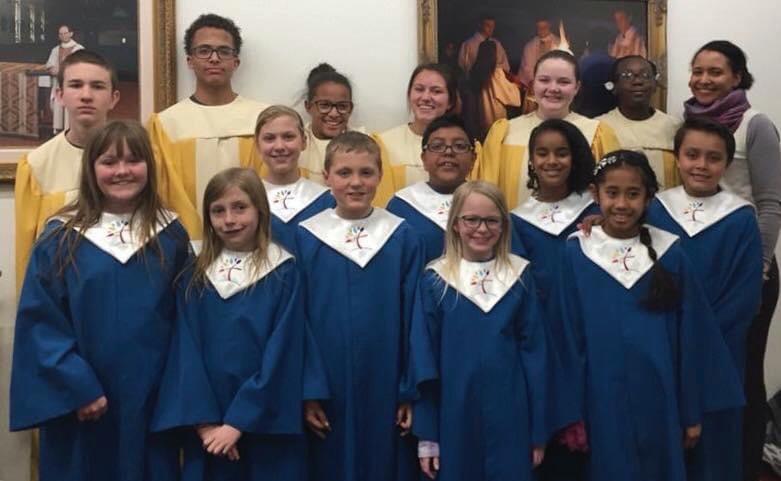
Genesis and Jubilation choirs during the Rocky Mountain Choristers Guild Choir Festival in Denver, Colorado.
One time we were singing “Al Shlosha D’varim” by Allan Naplan, a beautiful piece in Hebrew. When studying my octavo, I remembered that one of our ministers spent a lot of time in Israel and learned the language there. I asked him to share with our singers what it was like to be there and to help us with the pronunciation. He couldn't come to our rehearsal, but he made a video for us. He even made posters with the phonetic pronunciation of the text. Later that week I received an email from one of our families that was homeschooled at that time, saying that the video was part of their homeschool lesson for the week. We built connections.
●WHO IS OUR COMMUNITY? WHERE DO THEY COME FROM?
Our pianist last year was from China and I wished she was there when we sang “Gong Xi Gong Xi” (Congratulations!) by Chen Ge Xin and arranged by Lily Lung Grant. When I told her that we sang that song the year before, her eyes lit up. We sang a little for her — what we could remember, and she complimented our best attempt to sing in her tongue. By her reaction I knew she felt welcome.
●HOW CAN I MAKE THEM FEEL REPRESENTED?
My singers know that we will sing a wide variety of musical works every year. We sing only once a month and every month we perform something completely different...from spirituals, praise songs, songs from Justice Choir Songbook (justicechoir.org) or from Mark Miller’s Roll Down, Justice! Sacred Songs and Social Justice (Choristers Guild CGBK72), or traditional repertoire to songs out of a book from a small house church in Australia, or South African songs that we learn by rote. My congregation knows me and appreciates the diversity I bring to our worship services. Now when they travel, they bring books as presents and I make sure to include songs from those books in our services. My singers now expect to sing in Spanish (my first language) every year. Our city has a large Latinx community and I teach at a dual language school. My singers are used to hearing me greet them in Spanish. They trust me.
But I trust them even more! When we are working on anthems in English there is enough trust between us that if my diction is not entirely correct, they know they can address it in rehearsals. We look out for each other! You know this — we learn as much from our singers as they learn from us.
●WHAT RESOURCES DO I NEED TO ACHIEVE THESE GOALS?
I often find that the best way to approach a piece is by first reaching out to a community member that can offer an insight into the piece. When working on something that is beyond my expertise, either linguistically or stylistically, I rely on them to assist me. These kinds of opportunities bring authenticity to the experience. Build bridges between your larger community and your church community, they feel seen, appreciated, and that they belong here. Who knows? You might gain another singer for your choir too.
Pick composers that are from the culture that you are representing; whenever possible commission a new piece.
Lastly, and when the current situation with COVID-19 is over, travel with your choir. Allow them to experience a different culture. Our church takes groups of kids regularly
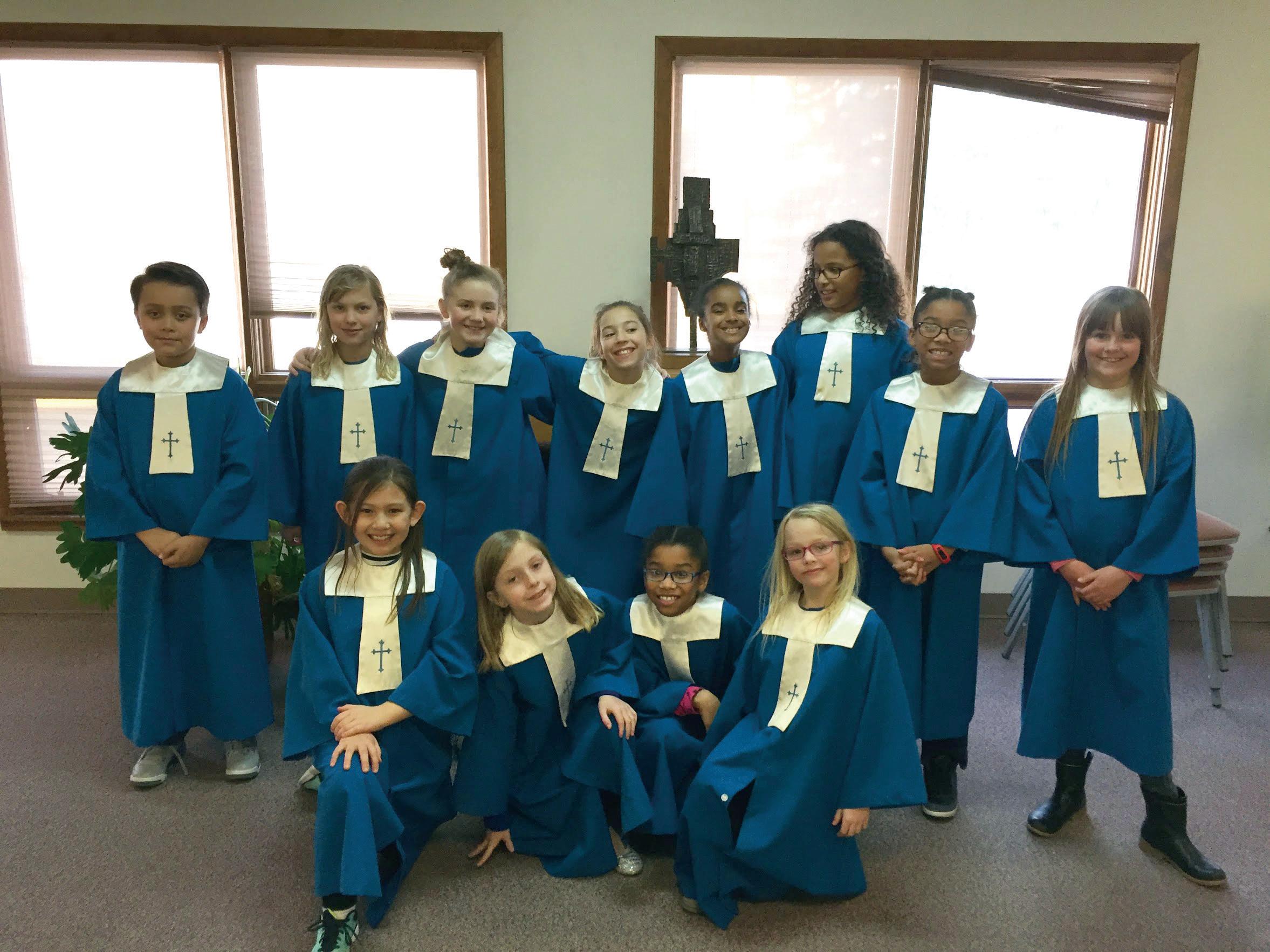
Jubilation Choir (2-5 graders)
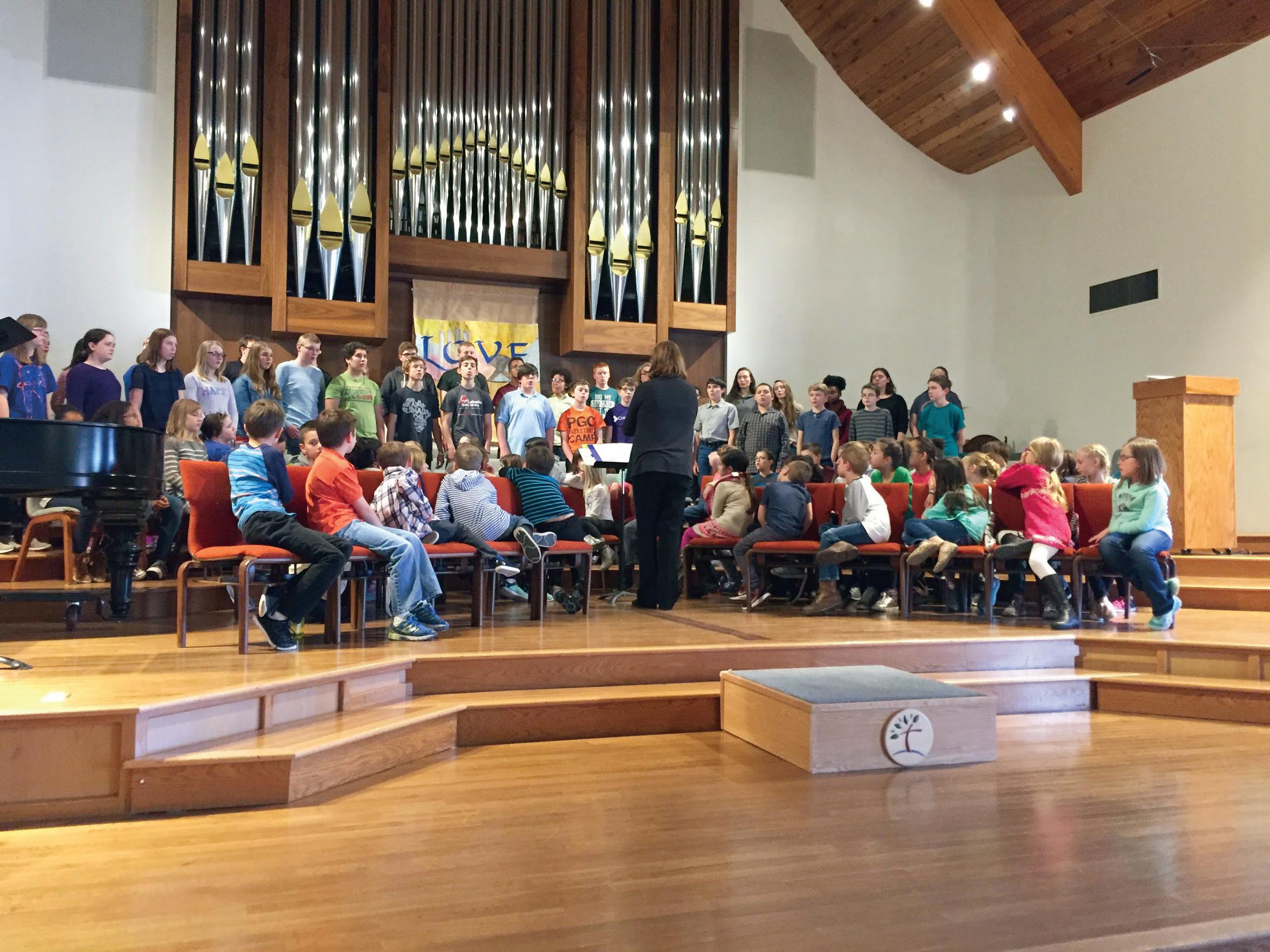
65th Annual Rocky Mountain Choristers Guild Choir Festival at our church First Congregational Church of Greeley, with Judith Herrington as Clinician. (2017)
to the Rosebud Indian Reservation. I can tell you that my singers describe these trips to the reservation as one of the most meaningful experiences they have ever been part of, including my own children. Because of those visits they have a better appreciation for the diversity around them. We travel every year as a choir to a neighboring community, as well as to attend the Rocky Mountain Choristers Guild Annual Festival. This past February was our 68th festival. I am so happy to contribute to the organization of this long-standing tradition.
●CREATE SPACES FOR YOUR STUDENTS TO TELL THEIR STORIES AND LEAD.
I recently worked with the Colorado Children’s Chorale as they are prepared for their holiday concert. They were working on “Duermete Mi Niño” from the Three Dominican Folksongs by Francisco Nuñez. It is a beautiful lullaby that you can use during the Advent season to celebrate the birth of our Savior. As I worked with them, their director Emily Crile asked me to share my favorite Christmas tradition, and so I did. Emily allowed time during every rehearsal for her singers to share their favorite winter tradition — opening space for all the different traditions celebrated by the singers. What a beautiful opportunity she is creating for her singers to share something that makes them unique! They feel seen and appreciated. This is an idea I will be implementing in my classroom, and in my choir room, as we prepare for our virtual Advent service and our first ever virtual pageant.
I want to encourage you to embrace the diversity that exists around you. Sing in many tongues, from many composers, from many cultures; use the resources that are around you, starting with your singers. They are your first and most valuable resource. Involve them in your planning process as much as you are able. Something that I am grateful for during this time is that everyone is just one Zoom call away.
It is my experience that this approach creates a welcoming environment for whoever walks through the doors of your sanctuary. Perhaps, if you create a more inclusive environment, no one will feel like I did during my first church experience in my new American home. Although I do recognize that first time experiences are always hard. If you don’t have a very diverse community, use this approach anyway. It will open the doors of the world to your congregation.
Looking back, I am grateful we kept attending our first church community because we later baptized our children there, and the church members hosted a celebration at the house of the pastor who first invited us. Remember, we are worshiping God with our brothers and sisters through our offerings of music.
Wanda Vásquez de Garcia is a music educator, choir director, clinician, and choir singer. A native of the Dominican Republic currently living in Colorado, she holds a Bachelor's Degree in Music Education from the Universidad Autónoma de Santo Domingo, first University in the American Continent, and a Master's Degree in Music Education with an emphasis on choral music from the University of Northern Colorado. Wanda is currently the general music teacher at the Escuela Bilingüe Pioneer in Lafayette, Colorado, and the children and youth choir director at First Congregational Church of Greeley, Colorado. As a K-5 music educator, she believes music is a very effective way to learn about cultures. She also believes in the importance of exploring diversity in ways that are fun, meaningful, and inclusive in order to embrace our differences with respect and tolerance. Wanda has presented clinics and reading sessions promoting multicultural music and music technology in the elementary classroom at Colorado ACDA, CMEA, and Little Kids Rock Modern Band Summit.

Wanda Vásquez de Garcia

